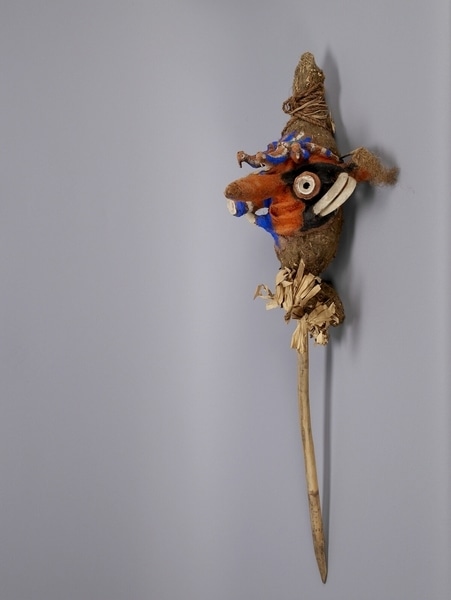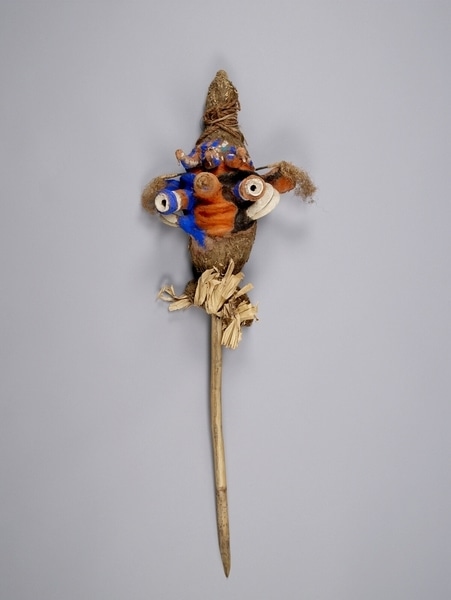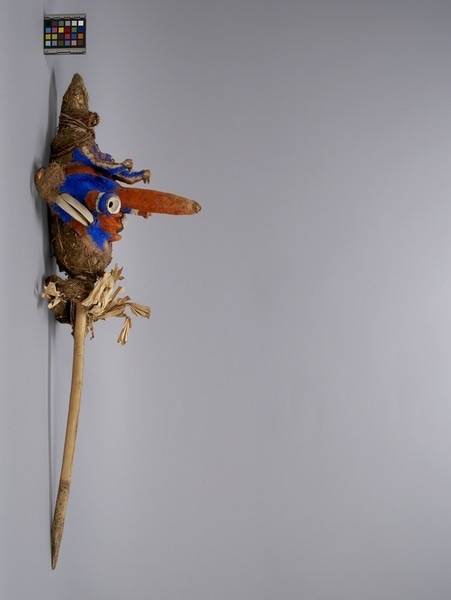Dance Staff Item Number: 2596/6 from the MOA: University of British Columbia




Description
Large figure head mounted on a wooden staff. Figure appears to have a wooden core, covered with clay and cobwebs. Vibrant blue, red and white paint cover the main surface of the face. Figure has a cone-shaped head wrapped with coir rope, protruding cylinder eyes and a long red nose. Two boar tusks curl upwards at each side of his mouth. Three vertically striped birds stick out from his forehead. Sticks with wound tufts of bushy grass fibres hang down over his ears.
History Of Use
Temes nevinbur, or dance staffs, are used as puppets during complex initiation ceremonies on the island of Malakula. The ceremonies, enacted by the Nevinbur secret society, are based on a myth about resurrection particular to Malakula Island, which involves the symbolic destruction of a family. The adults are personified by life-sized puppets and the children are represented by effigies on staffs- temes. Participation in the ritual is confined to members of the Nevinbur secret society and new initiates. All others are kept behind a fence, their view restricted to the tops of the temes that are held up and danced during the ceremonies. At the end of the ceremonies, the life-sized puppets are speared and burned, and some, or all, of the temes are destroyed. While the exaggerated features on the modelled faces of the temes are rather comical, the ceremony is viewed as both serious and sacred.
Narrative
Bossen worked as a veterinarian for FAO/UNDP in Samoa from 1973-75.
Item History
- Made in Malakula, Vanuatu during 1970
- Collected between 1973 and 1975
- Owned by Frits Bossen before October 8, 2003
- Received from Frits Bossen (Donor) on October 8, 2003
What
- Name
- Dance Staff
- Identification Number
- 2596/6
- Type of Item
- staff
- Material
- wood, clay, pandanus leaf, paint, boar tusk and silk fibre
- Overall
- height 73.5 cm, width 28.5 cm, depth 30.0 cm
Who
- Culture
- Ni-Vanuatu
- Previous Owner
- Frits Bossen
- Received from
- Frits Bossen (Donor)
Where
- Holding Institution
- MOA: University of British Columbia
- Made in
- Malakula, Vanuatu
When
- Creation Date
- during 1970
- Collection Date
- between 1973 and 1975
- Ownership Date
- before October 8, 2003
- Acquisition Date
- on October 8, 2003
Other
- Condition
- good
- Current Location
- Case 66
- Accession Number
- 2596/0006